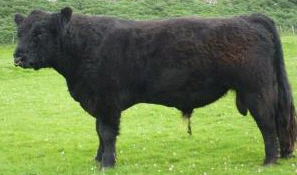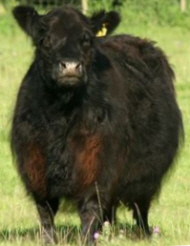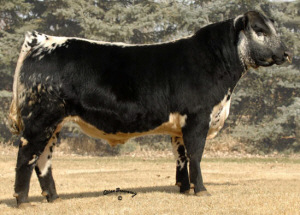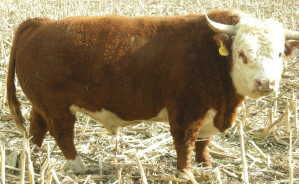



Galloway
History
Galloway, which has given its name to this breed of black or dun polled cattle, was an ancient regality or lordship lying in the south-west of Scotland. 'Galloway' is derived from the words Gallovid, or Gaul and the Gauls were the first to inhabit this part of Scotland.
 Photo courtesy of Erray Farm, www.erray.co.uk |
Much has been written of the history of British cattle since the middle of the 18th Century, the period immediately before that is almost without a record but there are points in which historians do agree upon.
The Galloway breed of cattle became important during the Scoto-Saxon period, and the breeders of Galloway enjoyed the export of cheese and hides. Later the cattle were sold in considerable numbers to English farmers who sent them to Smithfield market after a fattening period on English grass. It is said that the Galloway breed was never crossed with the other breeds. It is not known where the polled character was acquired by the Galloway breed because in its beginning many of the cattle were horned. However, many writers during the last part of the 1700's and early 1800's mentioned polled Galloway cattle, and the breeders decided they liked the polled characteristic and started selecting their cattle for the character. Most of the early cattle in the Galloway district were black, but red, brown, brindles, and cattle with white markings were not uncommon.
In 1851, a fire at the Highland Agricultural Museum at Edinburgh destroyed all the historical records and pedigrees of the Galloway collected prior to that time. Eleven years later (1862), a Polled Herd Book was published and it included the Galloway, Aberdeen, and Angus breeds. In 1878 the Galloway Cattle Society of Great Britain initiated its own volume of pedigrees. The first exportation of Galloways to North America came in 1853 to the Graham brothers of Toronto, Canada. From then on the Galloway was exported to America and to the rest of the world due to its great qualities.
The Galloway has produced the Belted Galloway and more recently the White Galloway and even the Poll Hereford.
Characteristics
Galloway's are mainly black with a brownish tinge, they are also bred in dun and black or dun belted, the latter being a recessive gene strain of red and white. They have a long, soft wavy coat which serves a dual purpose, the coarse outer coat sheds wind and rain, while the soft, fur-like under coat provides insulation and waterproofing.
Galloways are all hornless or polled although some writers say that formerly they were mixed, some being horned and others polled.
The breed is very docile and couragous, it has been said that they will team up and attack predators to prevent attacks on their calves. Even when there are just a few Galloways in a field of sheep, they will act the same making it safer for the sheep.
The Galloway is a maternal breed. The cows are easy calvers, while the calves themselves are hardy, vigourous and have a 'will to live' that gets them up and nursing quickly. The Galloway is long-lived, with many cows producing regularly into their teens and beyond.
 Photo courtesy of Erray Farm, www.erray.co.uk |
In confirmation the Galloway will be found to carry its meat from behind the shoulder along the back to the tail, through the buttock and deep into the hock; for this reason Galloway breeders, for centuries, have concentrated on this type of confirmation in their cattle and butchers have found that Galloways, in regard to their curability, marbling and colour of meat mature earlier than most other breeds of cattle.
Their flesh is mottled or marbled fat and lean intermixed, and it was this quality which gave them their ancient fame, and which led to their being bred specially to supply the markets of England with beef of extra quality.
Due to the breed's naturally dense, insulating hair coat the Galloway does not layer on excessive outside fat, which is generally discarded at slaughter time. Results of a multi-breed research project conducted by a Canadian Government Experiment Station, reveal that the Galloway ranks second only to the Buffalo in hair density tests. The robust, hardy nature of the Galloway has never been disputed. Though considered a breed for northern climates, the Galloway has been found to acclimate amazingly well to warmer regions.
Statistics
Comparative
The claim that Galloway beef is juicy, tender, and flavourful is substantiated in recent USDA tests of Galloway crossbreds, when compared with eleven other breeds. Results of the Cycle IV Germ Plasm Evaluation (GPE) Program at the USDA Meat Animal Research Center (MARC), Clay Center, Nebraska, showed the Galloway crosses placing at the top of the chart for flavour, juiciness and tenderness.
www.ansi.okstate.edu
MARC also found Galloways had the highest weaning percentage of US beef breeds and among the highest percentage of unassisted births. Galloway cows are known to produce for more than 20 years. Australian Department of Agriculture studies also confirm Galloway calving ease superiority.
Testing in Canada has found Galloway to be low in saturated fat and has been proven to be as healthy for the heart and brain as both chicken and fish.
Research at Montana State University in the USA shows beef cows with a hair coat just 25mm thicker need between 20-25 per cent less digestible feed intake to maintain body weight.
The February 2008 OLDS’ College (Alberta, Canada) report lists Galloway feed efficiency as an excellent 3.85, the average for the 17 breeds involved was 4.32, Canadian Angus required over 20% more feed than Galloway.
A 2006 meat marbling study, published in the respected Journal of Animal Science, showed Galloways having more marbling flecks in both number and proportion of muscle than other trialled breeds including German Angus. Galloways achieved this significant result with 6% less feed than the other breeds.
Galloways consistently score 6 and above (out of a max of 8) for Australian GeneSTAR’s feed efficiency and tenderness gene marker testing.
Galloway Cattle and Beef Marketing Association
The GC & BMA 2008 Annual provides more research and current marketing objectives, a very interesting read.
Distribution
 |
References (the above information was cited from the following sites)
www.ansi.okstate.edu
www.gallowaycattlesociety.co.uk
www.gallowaycattle.com.au
www.erray.co.uk


